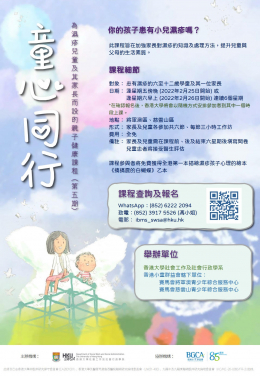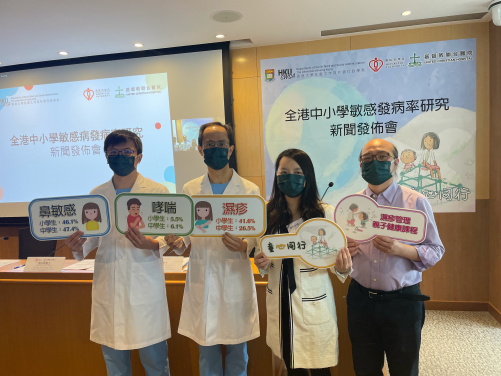Media
Survey findings on prevalence of allergic diseases among Hong Kong primary and secondary schoolchildren
13 Jan 2022
A collaborative study by the Department of Social Work and Social Administration, the University of Hong Kong and the Department of Paediatrics and Adolescent Medicine, United Christian Hospital
Background
Eczema, asthma, and rhinitis are three of the most common paediatric allergic diseases. Beyond persistent hallmark symptoms such as scratching, wheezing, and sneezing, allergic diseases impose a burden on the psychological aspects of life in both children and parents. As a result, as initiated by the Dr. Celia Hoi Yan Chan, Associate Professor and Deputy Head of the Department of Social Work and Social Administration of The University of Hong Kong (HKU) and Dr. David Luk, Dr. James Cheng and the pediatricians of the Department of Paediatrics and Adolescent Medicine of United Christian Hospital (UCH), a population-based International Study of Asthma and Allergies in Childhood (ISAAC) assessment was conducted in 2021, whereby over 2,200 schoolchildren and 1,800 parents were surveyed on the prevalence of allergic diseases and its mental health impact in Hong Kong.
The Latest Prevalence Study of Allergic Diseases among Hong Kong Primary and Secondary Schoolchildren after 18 years and 25 years respectively
- Although an increasing trend in the prevalence of eczema, asthma, and allergic rhinitis in children has been observed, updated prevalence rates from ISAAC studies are not available since 2004 for primary and 1997 for secondary schoolchildren in Hong Kong.
- As stated in the ISAAC protocol, target participants of ISAAC studies are a random sample of 6-7- and 13-14-year-olds. To obtain a representative sample, ISAAC recommends 3,000 participants from a minimum of 10 schools to be recruited for each age group.
- In light of the requirement, schools were randomly selected from each district during the first two rounds of recruitment. In each round, 14 primary and 14 secondary schools were invited to participate in the study.
- Due to low participation rates, a third round of recruitment was conducted. Nearly 900 invitation letters were sent to schools. Schools were also recruited from personal network. Physical copies of the questionnaires were sent to existing participating schools.
- Children and parents were invited to fill out questionnaires on the prevalence and severity of the allergic diseases, as well as psychosocial functioning of children and their parent caregivers.
Prevalence of Allergic Diseases among Hong Kong Primary and Secondary Schoolchildren in 2022
1. High Prevalence of Eczema and Rhinitis as compared with International Data
- Compared with international prevalence data on allergic diseases in 20131, eczema and rhinitis in the past year in Hong Kong primary schoolchildren were reported to be higher than those who resided in the Asia-Pacific region and most Western regions. Similarly, rhinitis in the past year in Hong Kong secondary schoolchildren were also higher than those reported in other regions of the world.
2. Huge Increase of Prevalence of Eczema and Rhinitis among Primary Schoolchildren since 2004
- From February to July 2021, primary one and two students from 19 primary schools and their parents had completed an online questionnaire. In total, self-reported data from 1,165 parent-child dyads were analyzed. The mean age of schoolchildren was 7.03 and 62% of schoolchildren were male.
- In the current study, the prevalence rates for eczema, asthma, rhinitis, and allergic rhinitis are 41.6%, 5.5%, 59.4% and 46.1% respectively.
- Compared with the last Hong Kong ISAAC in 20042, the prevalence of eczema, rhinitis and allergic rhinitis have largely increased. On the other hand, the prevalence rate of asthma has seen a minor drop (Appendix I, Figure 1).
- When primary one and two respondents were asked whether they had experienced symptoms of allergic diseases in the past year, 16.3% had experienced chronic rash (eczema), 6.2% had experienced wheezing (asthma) and 54.4% had experienced rhinitis.
- Male respondents were significantly more likely to experience wheezing in the past year, rhinitis, and allergic rhinitis than female respondents (see Appendix II, Table 1).
3. Rhinitis is the Most Prevalent Allergic Diseases among Secondary Schoolchildren between 1997 and 2022
- Form Two and Three students from 25 secondary schools and their parents had completed the online questionnaire. In total, self-reported data from 1,083 secondary school students and 636 parents were analyzed. The mean age of schoolchildren was 14.09 and 57% of schoolchildren were female.
- In the current study, the prevalence rates for eczema, asthma, rhinitis, and allergic rhinitis are 26.5%, 6.1%, 62.0% and 47.4% respectively, in which rhinitis is the most prevalent allergic diseases among the Form Two and Three respondents.
- Compared with the last Hong Kong ISAAC study in 19973, the prevalence rate of eczema and rhinitis has substantially increased, but the prevalence of asthma has decreased (Appendix I, Figure 2).
- In the current study, 10.4% of Form Two and Three students have experienced chronic rash (eczema), 5.0% have experienced wheezing (asthma) and 55.0% have experienced rhinitis.
- Male respondents were more frequently diagnosed with asthma than teenage females (see Appendix III, table 4).
4. Possible Causes behind the Change of Prevalence of Allergic Diseases for Primary and Secondary Schoolchildren
- A combination of environmental factors, such as the increased uptake of processed and high calorie foods, rising prevalence of obesity and climate changes; exacerbated by COVID-19 related factors, such COVID-19 related stress and changes in outdoor physical activities account for the increasing prevalence of eczema.
- Diagnostic shifts, changes in respiratory risk factors and behaviour due to COVID-19 are possible explanations for the changes in prevalence of rhinitis and asthma.
The Challenge of Rendering Psychosocial Support for Children with Allergic Diseases (See Appendix II, Table 2 and 3)
- Results indicated children with more severe eczema reported diminished levels of physical, emotional, social, and psychosocial functioning.
- More severe allergic rhinitis in children were associated with higher levels of stress, depression, and anxiety, as well as lower levels of efficacy and sense of competence in parents. In other words, parents were more likely to feel stressed, anxious, depressed, and incompetent if their children had more severe allergic rhinitis.
- Previous research indicated that parents of children with eczema reported higher levels of stress and depression, as well as greater sleep disturbances4. Given the highly fluctuating and unpredictable nature of eczema, constantly attending to, and worrying about the symptoms of the disease is a physical and mental challenge for parents of children with eczema.
“Seeing the Invisible” – Eczema Management Parent-child Education Programme
- As initiated by the Department of Social Work and Social Administration of the University of Hong Kong (HKU) and in collaboration with the Boy’s and Girl’s Clubs Association of Hong Kong (BGCA), “Seeing the Invisible” - Eczema Management Parent-child Education Programme will be launched in February with the aim to strengthen parents’ knowledge of eczema and its management techniques, and to improve the quality of life of children with eczema and their parents (see Appendix IV for more details).
Summary
- There was an observable rise in prevalence of eczema and rhinitis when compared with previous ISAAC findings. Primary schoolchildren were more likely to be diagnosed with eczema than secondary schoolchildren.
- Changes in prevalence of allergic diseases can be divided into a myriad of environmental factors and COVID-related factors.
- Allergic diseases are not only detrimental to the health and psychosocial functioning of schoolchildren, but it also impacts parents’ quality of life.
- In combating eczema, there is a need to equip the families with eczema-related knowledge and management strategies. “Seeing the Invisible” - Eczema Management Parent-child Education Programme is an evidence-based non-pharmaceutical programme designed for children with eczema and their parents, with the aim to improve parents’ knowledge of eczema, as well as both of their quality of life.
Please click here for the appendix.
Please click here for the powerpoint slides at the press conference (Chinese only).
Enquiry
Research:
Dr. Yat Lui Fung, Project Manager
Department of Social Work and Social Administration
The University of Hong Kong
Phone: 3917-1160 | Email: yl.fung28@hku.hk
Media:
Ms. Melanie Wan, Senior Manager (Media)
Communications and Public Affairs Office
The University of Hong Kong
Phone: 2859 2600 | Email: melwkwan@hku.hk
1Mallol, J., Crane, J., von Mutius, E., Odhiambo, J., Keil, U., & Stewart, A. (2013). The International Study of Asthma and Allergies in Childhood (ISAAC) Phase Three: A global synthesis. Allergologia Et Immunopathologia, 41(2), 73-85. doi: 10.1016/j.aller.2012.03.001
2Lee, S., Wong, W., & Lau, Y. (2004). Increasing prevalence of allergic rhinitis but not asthma among children in Hong Kong from 1995 to 2001 (Phase 3 International Study of Asthma and Allergies in Childhood). Pediatric Allergy And Immunology, 15(1), 72-78. doi: 10.1046/j.0905-6157.2003.00109.x
3Leung, R., Wong, G., Lau, J., Ho, A., Chan, J., Choy, D., Douglass, C., & Lai, C. (1997). Prevalence of asthma and allergy in Hong Kong schoolchildren: an ISAAC study. European Respiratory Journal, 10(2), 354-360. doi: 10.1183/09031936.97.10020354
4Moore, K., David, T., Murray, C., Child, F., & Arkwright, P. (2006). Effect of childhood eczema and asthma on parental sleep and well-being: a prospective comparative study. British Journal Of Dermatology, 154(3), 514-518. doi: 10.1111/j.1365-2133.2005.07082.x


